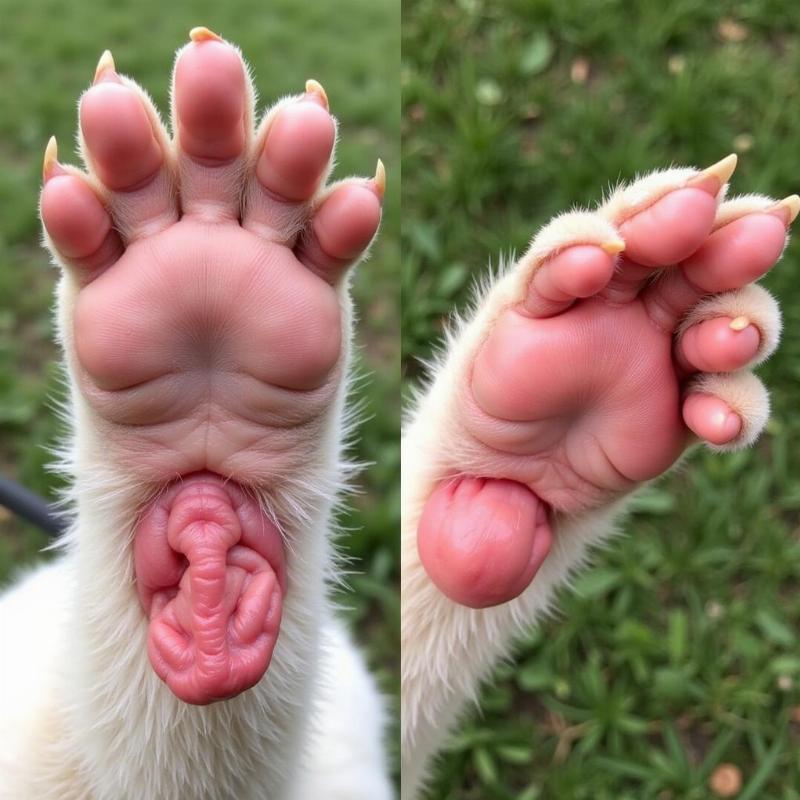American dagger moths are a common sight across the US, but their fuzzy caterpillars can pose a risk to curious dogs. While not technically poisonous, their spiny hairs contain irritants that can cause a range of reactions, from mild skin irritation to more serious issues if ingested. Understanding the risks and knowing what to do if your dog encounters an American dagger moth caterpillar is crucial for responsible pet ownership in the US.
Are American Dagger Moth Caterpillars Poisonous? Understanding the Threat
Technically, American dagger moth caterpillars aren’t poisonous, but they are venomous. This means they don’t secrete toxins passively but rather inject them through their spiny hairs. These hairs, called urticating hairs, contain a chemical irritant that can cause localized reactions in dogs. The severity of the reaction depends on the dog’s sensitivity, the amount of contact, and whether the hairs were ingested or simply touched.
Symptoms of American Dagger Moth Caterpillar Exposure in Dogs
If your dog comes into contact with an American dagger moth caterpillar, you might observe several symptoms. These can range from mild to moderate, and in rare cases, severe. Common signs include:
- Skin irritation: Redness, swelling, and itching are typical reactions. Your dog may excessively lick or scratch the affected area.
- Pawing at the mouth: If your dog has mouthed or ingested the caterpillar, it might paw at its mouth due to pain and irritation.
- Drooling: Increased salivation is another common sign of oral exposure.
- Vomiting: This can occur if the caterpillar is ingested.
- Difficulty breathing: In rare instances, a severe reaction might lead to swelling in the airways, making it difficult for your dog to breathe.
What to Do If Your Dog Encounters an American Dagger Moth Caterpillar
Quick action is crucial if your dog comes into contact with an American dagger moth caterpillar. Here’s a step-by-step guide:
- Remove the caterpillar: If the caterpillar is still on your dog, carefully remove it using gloves or a towel. Avoid direct contact with the caterpillar’s hairs.
- Rinse the affected area: Flush the area with cool water to help remove any remaining hairs and soothe the irritation.
- Monitor your dog: Observe your dog closely for any signs of worsening symptoms.
- Contact your veterinarian: If your dog exhibits moderate to severe symptoms, or if you’re unsure about the severity of the reaction, contact your veterinarian immediately.
 Dog Paw Irritation
Dog Paw Irritation
Preventing American Dagger Moth Caterpillar Encounters
While completely eliminating the risk is difficult, you can take steps to minimize your dog’s exposure to these caterpillars:
- Be aware of their habitat: American dagger moths are common in wooded areas and gardens. Be extra vigilant when walking your dog in these environments.
- Train your dog to “leave it”: This command can be invaluable in preventing your dog from investigating or picking up potentially harmful insects.
- Regular yard maintenance: Keep your yard clean and free of debris, which can attract insects.
Expert Insights
“It’s always better to be safe than sorry,” says Dr. Emily Carter, DVM, a veterinary dermatologist based in Austin, Texas. “If you suspect your dog has encountered an American dagger moth caterpillar, even if the symptoms seem mild, it’s best to consult your veterinarian. Early intervention can prevent potential complications.”
Conclusion
American dagger moth caterpillars, though not poisonous, can pose a threat to your dog’s health due to their irritating hairs. Understanding the risks, recognizing the symptoms, and taking preventative measures can help keep your furry friend safe from these common pests. By being proactive and informed, you can ensure that your dog enjoys the great outdoors without unnecessary discomfort or danger.
FAQ
- Are American dagger moths deadly to dogs? While rare, severe reactions can occur. It’s crucial to seek veterinary care for any moderate to severe symptoms.
- What is the best way to remove a caterpillar from my dog? Use gloves or a towel to avoid direct contact with the hairs.
- How long do the symptoms of exposure last? Symptoms typically subside within a few days, but severe reactions may require veterinary intervention.
- Can I treat my dog’s symptoms at home? Mild irritation can be soothed with cool water rinses. Consult your vet for any other treatments.
- Are all caterpillars venomous? No, only certain caterpillars, like the American dagger moth, have urticating hairs.
- What time of year are American dagger moth caterpillars most active? They are typically active during the summer and fall months.
- Where can I find more information about poisonous insects and my dog? The ASPCA Animal Poison Control Center is a valuable resource.
Beautdogs.us: Your Trusted Source for Dog Care
Beautdogs.us is your go-to online destination for all things dog-related in the US. We offer comprehensive, reliable, and engaging information on dog breeds, care, and products. Whether you’re a seasoned dog owner or just starting your journey with a furry companion, Beautdogs.us provides expert advice and valuable resources to help you provide the best care for your beloved pet. Contact us for personalized support: Email: [email protected], Phone: +1 501-555-7529.